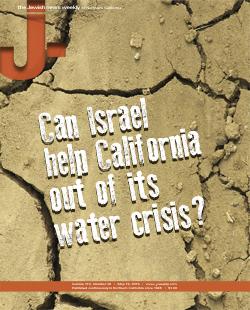
At Tze’elim reservoir in the Negev, Israeli startup Neotop tests new technology that reduces surface temperatures, algae and evaporation.
From a distance, the reservoir appears topped by a flotilla of rubber duckies.
On closer inspection, the water’s surface is packed with thousands of free-floating, 13-inch plastic balls, clustered to form an undulating cover.
Developed by the Israeli startup Neotop (formerly known as Top-It-Up), the mass of balls serves as a floating cooling tower, reducing surface temperatures, algae and evaporation up to 95 percent. It’s one of many potential water-saving solutions to come out of Israel’s high-tech dream factory.
This could make a difference in California. With the state’s reservoirs at historic lows – the two biggest, Shasta Lake and Lake Oroville, both down 40 percent – every drop counts.
Living in a land of permanent water scarcity, Israelis grow up with a credo of water conservation. The country pioneered drip irrigation and wastewater recycling. As California bakes in its fourth year of exceptional drought – the worst stretch in 1,200 years – Israel has much to offer by way of remedies.
Sectors of California’s agriculture industry, such as grape growers, long ago took up Israeli-style drip irrigation. And this fall, the largest ocean desalination plant in the Western Hemisphere, a project designed and being built by IDE Technologies of Israel, is set to open near San Diego.
With the drought worsening, state water managers have been seeking Israeli expertise. On June 11, Israeli hydrologists and entrepreneurs will meet in Sacramento with state politicians, academics and other water experts for a daylong conference titled “Israel Water Technology: Opportunities for California.” Together they will explore ways to bring Israeli experience and know-how to California.
Noam Levy, for one, hopes Neotop has a future in the Golden State.“We are just beginning commercialization of the project and manufacture in Israel,” said Levy, the company’s CEO. “We are aiming for the U.S. market, mainly California.”
Reservoir preservation is one piece of California’s complicated water puzzle. Aging infrastructure and an antiquated patchwork of water agencies make it difficult to reach consensus about how best to address the crisis.
Stakeholders include agriculture, industry, cities and Mother Nature herself, which depends on plentiful fresh water to maintain eco-balance.
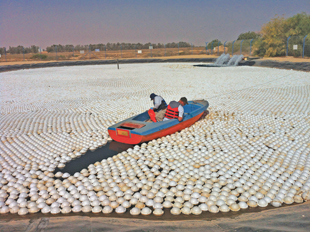
At Tze’elim reservoir in the Negev, Israeli startup Neotop tests new technology that reduces surface temperatures, algae and evaporation.
Once abundant, water is hard to come by in the age of climate change. According to the California Department of Water Resources, 2012-2014 was the driest three-year period on record. Last month, the Sierra Nevada snowpack measured 5 percent of average, the lowest in history.
In January, Gov. Jerry Brown declared a drought state of emergency, with the State Water Resources Control Board ordering new restrictions on water use, including limiting outdoor watering to two days per week.
Then in April, Brown ordered mandatory 25 percent water reductions in cities and towns, and though those restrictions went into effect this month, so far compliance has been laughably low.
Israel water experts interviewed for this article generally agree that to achieve water security, the state must invest more in such strategies as desalination, conservation and wastewater recycling.Israeli technology has all three covered.
“We’re much smaller than California,” said Brian Berkowitz, chair of hydrology at Israel’s Weizmann Institute of Science, “but it’s a microcosm of what needs to be done. It starts with water reuse.”
Israel does that on a grand scale, leading the world in water reuse. The Global Water Forum estimates the country recycles 75 percent of its wastewater, and will hit 95 percent by 2017. Spain comes in a distant second at 13 percent.
The figure for the United States: 1 percent.
Virtually all sewage and wastewater from Tel Aviv is thoroughly treated before being injected into the ground to recharge aquifers and piped to the Negev Desert for use as irrigation water. More than 50 percent of water used in agriculture comes from treated sewage, according to the Israel Water Association, and Israeli farmers are only too happy to use it to make the desert bloom.
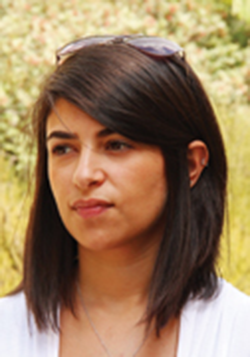
Sivan Cohen
In addition to water reuse, Israeli agriculture has replaced its thirstiest crops. Remember when Israel was the orange grove to the world? Not anymore.
“There was a major switch in Israel,” Berkowitz said. “We pulled the orchards up and started growing flowers. The farmers are much happier and doing better growing flowers. Now we’re exporting bulbs to Holland.”
In contrast, critics have accused California’s almond industry, which siphons off 10 percent of the available water, of exploiting water resources. Today every school child learns it takes a gallon of water to grow a single almond.
Israel also developed technology to keep tabs on the water it pumps. The task requires state-of-the-art monitoring systems of the sort manufactured by Ayyeka, a Jerusalem-based company.
Sivan Cohen, Ayyeka’s director of business development, thinks California could use a monitoring upgrade. She would know. She grew up in Los Angeles and attended both U.C. Berkeley (class of 2006) and Stanford University, majoring in civil engineering.
“In cities, between 20 and 50 percent of all water sent into the system is lost,” Cohen said. “That’s a general figure for large cities, but it’s worse in places with old faulty [water] infrastructure. In most of the United States, that infrastructure is up to 80 years old.”
Water can trickle away due to pressure drops, leaky pipes and other mishaps. Only a smart monitoring system will detect the locations of leaks and other problems.
“We hook up all kinds of sensors,” Cohen said. “They monitor pH, pressure, temperature, conductivity, turbidity. We also have units in the Sea of Galilee to monitor pressure in conveyance systems there.”
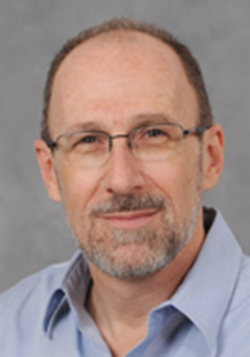
Brian Berkowitz
So far Ayyeka has yet to break into the California market, but with her local origins, Cohen hopes to persuade water districts such as the San Francisco Public Utilities Commission to give her product a shot. She will be on one of the panels at the June 11 conference in Sacramento.
Israeli desalination has already arrived. IDE Technologies is finishing construction of the Carlsbad Project north of San Diego. When it opens, it will turn 100 million gallons of seawater into 54 million gallons of clean drinking water every day, 7 percent of San Diego County’s water demands.
IDE touts the facility’s modern technology, and according to the company website, the plant will operate with lower energy consumption and a net-zero carbon footprint. In Israel, with more than six active seaside plants and several inland, economies of scale have dramatically dropped the price of desalinated drinking water.
But desalination is far from a slam-dunk solution here. Critics cite exorbitant construction costs (an expected $1 billion for the Carlsbad plant), the huge energy requirements to run a plant and ecological concerns. Also, projects like this need to get through a ton of red tape, including approvals from a long list of regulatory agencies and commissions.
And what happens if it starts raining again?
Opponents claim that when rain returns to California, desalination plants will become white elephants. That happened to a $34 million plant near Santa Barbara, built in response to the 1986-1991 drought, opened in 1992 and shuttered only three months later when the rains returned. City leaders are contemplating reopening it.
Then there’s the brine, the leftover salts and other impurities removed during the desalination process. The stuff can be toxic to sea life when dumped back into the ocean, which is standard operating procedure for plants.
Israeli desalination scientists understand the criticisms but believe innovators have solved the problems.
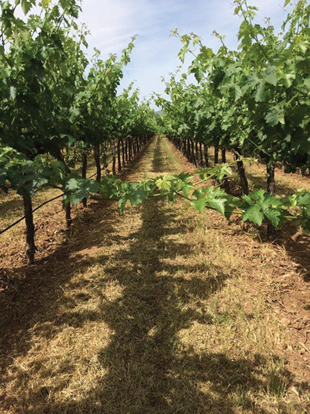
Hagafen Cellars in Napa uses Netafim’s drip irrigation system.
Jack Gilron, chair of the department of desalination and water treatment at Israel’s Ben-Gurion University of the Negev, has developed membrane technology for desalination and wastewater treatment.
“Some technological firsts have been done here,” Gilron said. “Our [Ashkelon] plant has a capacity of 630,000 cubic meters [166,400 gallons] a day. It is the first large-scale plant to operate with vertically mounted pressure vessels, and is the largest in the world, or near the top.”
He said Israeli scientists are working on solving thorny issues related to mechanical stress in desalination plants, such as how to build stronger membranes to tolerate the high pressures at which water is forced through via reverse osmosis.
As for the brine, Gilron said Israeli desalination plants minimize harm by diluting brine with the seawater used to cool the plants before injecting the salty mixture into the sea at discharge points.
“Spread over a large enough area far enough from the coast, [studies] show salinity would drop to normal sea values,” he said. “There was no deleterious effect on natural ecology.”
Drip irrigation was pioneered in Israel back in the 1950s and has been in use for decades. The Israeli company Netafim is one of the largest in the world, with a Fresno office and plenty of California customers. Farmers, growers and winemakers cultivating more than 1 million acres in the state use Netafim systems.
One of them is Ernie Weir, winemaker at Hagafen Cellars, the largest kosher winery in the Napa Valley. Having lived in Israel as a young man, Weir saw firsthand the benefits of drip irrigation, a method he imported to his vineyards.
“Most of us who grow wine grapes have been very sensitive to not over-irrigate to begin with,” Weir noted. “That produces a better crop. We have abundant rainfall usually, and we grow grapes that, if done correctly, do not require large amounts of water.”
Weir understood that drip was the best way to irrigate. Upfront investment costs were low, and the water required was a fraction of that used in flood or sprinkler irrigation.
The technology has improved over the years. The latest systems are subsurface, which further conserves water, controls weeds and minimizes runoff. Today meteorological sensing devices show how much water farmers might need on a given day, and new irrigation controllers can be operated by smartphone.
Despite the drought, Weir is not worried. Enough rain fell this season to bring about bumper grape harvests. But he knows the state will be in trouble if the drought drags on.
“Everyone is facing a water problem,” he said. “It’s something we’re going to have to deal with. California’s infrastructure perhaps is not adequate, but we’re an awfully clever and adaptive people.”
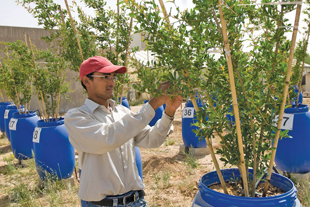
A BGU desert studies graduate student monitors pomegranate trees grown in containers. photo/dani machlis-bgu
For all their advice, some Israeli water scientists and entrepreneurs question if California will ever have the right stuff to solve its woes. Given the state could produce ample water supplies if decision-makers were willing to invest in the technology, such as wastewater treatment, those experts say the state does not have a water crisis as much as it has a political crisis.
“One of the main problems in California is the lack of global water policy for the state,” said Moshe Gottlieb, a chemical engineering professor at Ben-Gurion University. “It’s more a water management issue rather than lack of water technology.”
Gottlieb’s research centers on water contamination and improving performance of desalination membranes. He’s had a relatively easy time of it in Israel because one national agency, Mekorot, covers everything to do with water, from sewage treatment to moving water from north to south.
“With this global approach,” he said, “we’re very efficient in recycling water. We ship [recycled water] to the Negev, and we moved all the orchards [to the Negev] from central Israel. This is akin to moving the fruit growers from [California’s] Central Valley to the Mojave Desert by cleaning the sewage [wastewater] of L.A. and the Bay Area and shipping the water down.”
Then he added, “The way I hear it, things [in California] are pretty much as they are in ‘Chinatown.’ ”
He didn’t mean the iconic San Francisco neighborhood. He meant the 1974 Roman Polanski movie, a neo-noir mystery that was based on the epic battles over Southern California water rights at the beginning of the 20th century.
That film fictionalized the dirty, high-profit deals made to turn Los Angeles from a quasi-desert to one big orange grove. Gottlieb believes a drought-plagued region like California requires top-down central planning.
“If you’re using drinking water for agricultural purposes and dumping [treated] sewage into the ocean, rather than having a statewide policy dealing with water, it’s a problem,” Gottlieb said. “Don’t waste good drinking water.”
Eilon Adar, a professor in the Department of Environmental Hydrology and Microbiology at Ben-Gurion University, has met several times with state government and industry, and will return for the water symposium in Sacramento next month. Adar wants to help, but he worries the gulf between the Israeli way of water management and California’s may be too great.
“I know California is looking at Israel in the sense that we are also a semi-arid region that managed to overcome scarcity,” he said. “But I don’t think it’s easy. The main reason: In Israel, water is a national resource.”
He recently met with an aide to Gov. Brown who asked Adar about ways to solve California’s water problems. Adar’s reply: The state has plenty of water but is handicapped by outdated laws.
“In California, if you own the land you own the ground water and can sell your water rights to someone else,” he said. “In Israel, we can’t pump from our private wells. You own the surface rights but not the subsurface rights. This saved our country. Based on this difference, it is very difficult to adopt what we did in Israel to California.”
Adar’s view is bolstered by the state’s Department of Water Resources, which in its latest report admits that a “key gap to implementing sustainable groundwater management practices at the local level is the limited authority of some agencies to assess management fees, restrict groundwater extraction, regulate land use in groundwater-short areas and more broadly protect groundwater recharge areas.”
In other words, even in the face of exceptional drought, property rights trump the greater good.
Peter Brostrom, the water-use efficiency program manager for the state, admires what Israel has done technologically and thinks California must consider all remedies, including more efficient conservation measures. But he has in mind one optimum remedy that tops all others.
“In my mind, the real solution is more rain,” Brostrom said. ”We’re gong to have to respond and adapt, but we’re in such a hole now it will really take years to get us back to normal.”
It would also take years to build new desalination and wastewater treatment plants. That’s why Brostrom looks favorably on simpler solutions.
The Metropolitan Water District of Southern California offers cash rebates to homeowners who replace turf lawns with shrubs, perennials and other less thirsty plants. Brostrom said MWD (a consortium of 26 cities and water districts that provides drinking water to nearly 19 million people in Los Angeles, Orange, San Diego, Riverside, San Bernardino and Ventura counties) receives 2,000 calls a day requesting rebates.
He also noted that 70 percent of toilets currently in use in the state are of the water-smart low-flush variety. But that leaves as many as 10 million water-wasting toilets still in need of replacement. Replace those and California will save big.
“The new water supply of having more efficient toilets may be one-tenth the cost of building a desalination plant,” he added.
As the rainless days drag on, Californians have stopped watching the skies and have begun exploring viable short-term and long-term solutions to the drought.
And Levy hopes Neotop’s reservoir balls can be part of that solution.
“I’m a born Israeli,” he said. “When it rains here it’s a big celebration. It goes without saying that water is essential and needs to be treated carefully. We always think about how to save water. It’s in the Israeli DNA.”
